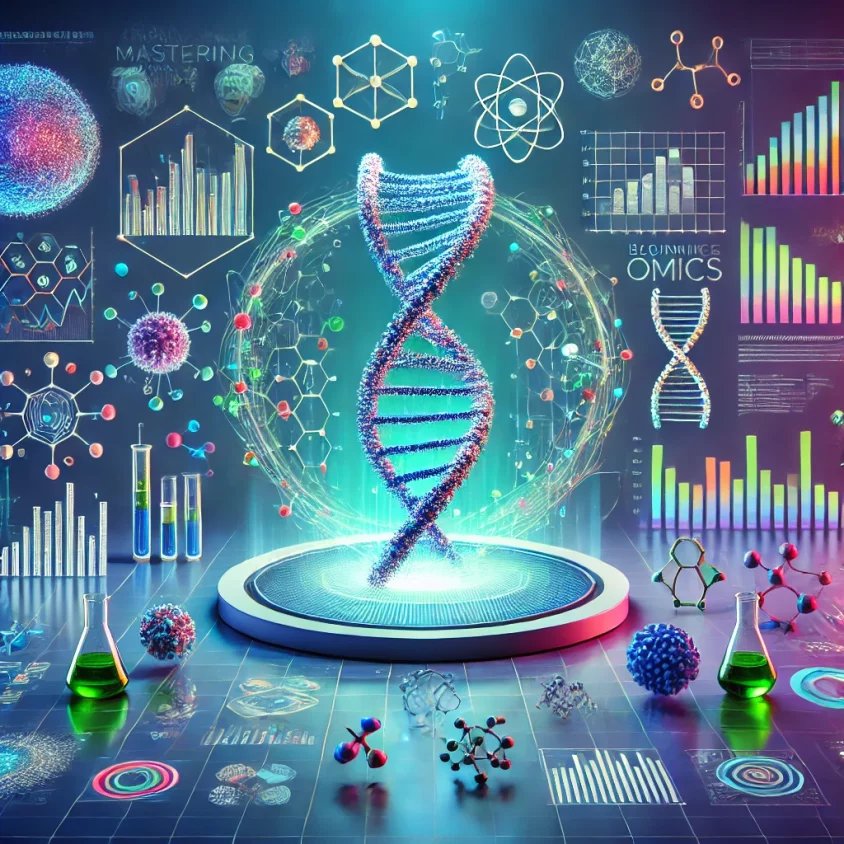Mastering Omics: A Beginner’s Guide to Genomics, Proteomics, and Metabolomics

Course Overview
Welcome to Mastering Omics: A Beginner’s Guide to Genomics, Proteomics, and Metabolomics! This course is a self-paced, comprehensive resource designed for readers seeking a detailed understanding of the omics sciences. Without requiring additional guidance or external instruction, this course equips you with the knowledge to independently grasp the concepts, methodologies, and applications of genomics, proteomics, and metabolomics. Whether you’re a beginner or someone looking to enhance your expertise, this guide provides the foundation you need to explore these exciting fields.
Why Study Omics?
Omics sciences are transforming our understanding of life at the molecular level. Here’s why mastering omics is essential:
Unravel Complex Biological Systems: Learn how the genome, proteome, and metabolome work together to maintain life.
Advance Healthcare and Medicine: Gain insights into personalized medicine, drug discovery, and disease diagnostics.
Empower Research and Innovation: Equip yourself with knowledge applicable to cutting-edge research in biotechnology, agriculture, and environmental science.
Course Content
This course is structured into five detailed modules to ensure a thorough understanding of the topic.
Module 1: Introduction to Omics Sciences
1.1 What are Omics?
Omics refers to comprehensive approaches for studying biological molecules in systems biology.
Key fields: genomics (genes), proteomics (proteins), and metabolomics (metabolites).
1.2 Historical Perspective
Early discoveries in genomics with the Human Genome Project.
Evolution of proteomics and metabolomics technologies.
1.3 Significance of Omics
Integration of omics to understand biological pathways and networks.
Examples of omics in solving real-world problems.
1.4 Tools and Resources
Databases and platforms for omics studies (e.g., NCBI, UniProt, KEGG).
Module 2: Genomics – Decoding the Blueprint of Life
2.1 The Genome: An Overview
Definition of the genome as the complete set of an organism’s DNA.
Key features of eukaryotic and prokaryotic genomes.
2.2 Genomics Technologies
DNA Sequencing:
Techniques: Sanger sequencing, Next-Generation Sequencing (NGS), and third-generation sequencing.
Applications: Whole-genome sequencing, transcriptomics, and epigenomics.
Genome Editing:
CRISPR-Cas9 technology and its applications.
Bioinformatics in Genomics:
Tools for analyzing genomic data (e.g., BLAST, Ensembl).
2.3 Applications of Genomics
Medicine: Genetic testing, pharmacogenomics, and gene therapy.
Agriculture: Genetically modified organisms (GMOs) and crop improvement.
Research: Evolutionary studies and biodiversity assessment.
Module 3: Proteomics – Understanding the Protein Universe
3.1 Introduction to Proteins
Structure and functions of proteins as biological macromolecules.
The proteome: Dynamic and context-dependent.
3.2 Proteomics Techniques
Mass Spectrometry (MS):
Principles: Ionization, detection, and analysis.
Applications: Protein identification, quantification, and post-translational modifications (PTMs).
Two-Dimensional Gel Electrophoresis (2D-GE):
Separates proteins based on isoelectric point and molecular weight.
Protein Interaction Studies:
Techniques: Yeast two-hybrid screening, co-immunoprecipitation, and crosslinking.
3.3 Applications of Proteomics
Biomarker Discovery: Identifying proteins as indicators of disease states.
Drug Development: Target identification and validation.
Structural Biology: Protein folding and interactions.
Module 4: Metabolomics – Exploring the Metabolome
4.1 Introduction to Metabolomics
The metabolome represents the complete set of small molecules in a biological system.
Metabolomics aims to analyze metabolic pathways and their regulation.
4.2 Analytical Techniques in Metabolomics
Nuclear Magnetic Resonance (NMR): Provides structural and quantitative data.
Gas Chromatography-Mass Spectrometry (GC-MS): Ideal for volatile and semi-volatile compounds.
Liquid Chromatography-Mass Spectrometry (LC-MS): Suitable for complex metabolite mixtures.
Capillary Electrophoresis-Mass Spectrometry (CE-MS): Analyzes ionic compounds.
4.3 Applications of Metabolomics
Medicine: Metabolic biomarkers for cancer, diabetes, and neurological disorders.
Nutrition: Understanding dietary impacts on metabolism.
Environmental Science: Assessing the effects of pollutants.
Module 5: Integration of Omics
5.1 Systems Biology
Omics as the foundation of systems biology.
Combining omics data to model and predict biological behavior.
5.2 Computational Tools for Multi-Omics
Overview of platforms like Cytoscape, STRING, and KEGG.
Challenges in handling and interpreting large datasets.
5.3 Case Studies
Cancer Research: Using genomics and proteomics to identify therapeutic targets.
Agriculture: Multi-omics for improving crop resilience.
Microbiology: Integrating omics to study microbial communities.
Learning Outcomes
By completing this course, readers will:
Understand the core principles of genomics, proteomics, and metabolomics.
Familiarize themselves with cutting-edge technologies used in omics research.
Explore real-world applications and their impact on science and society.
Develop confidence in analyzing and interpreting omics data using computational tools.
BOLG provides a platform to explore the fascinating world of molecular biology through in-depth, self-paced courses. This guide empowers you to independently master the essentials of genomics, proteomics, and metabolomics. Whether you’re starting your academic journey or looking to expand your professional expertise, BOLG is your gateway to unlocking the potential of omics sciences.